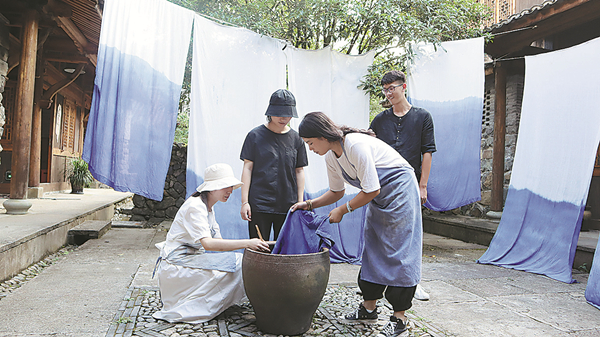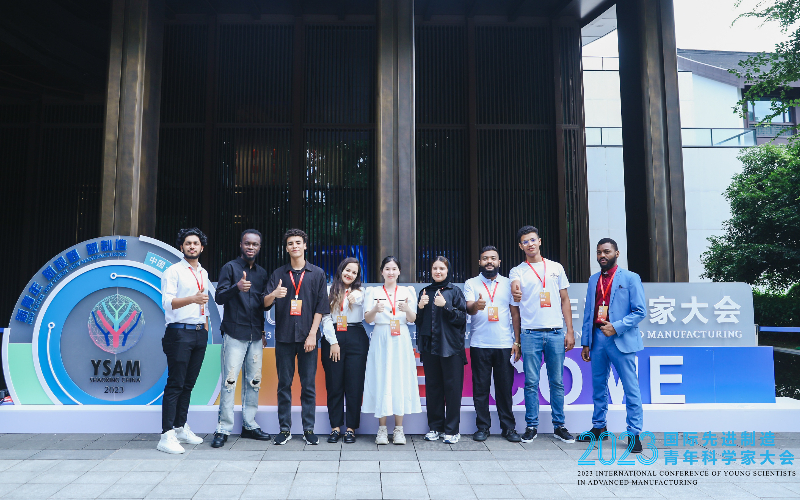Determined villagers embark on new ventures

Tourists learn about traditional cloth dyeing techniques in Wuyantou village, Taizhou, Zhejiang. [Photo/China Daily]
Although villages comprise more than 60 percent of the total area of Huangyan district, Taizhou city, Zhejiang province, private enterprise is thriving in the area.
For example, more than 2,000 mold-making companies account for 10 percent of the industry's national output.
Zhang Xunqiang took over his family's mold manufacturing business after graduating from university in 2009.
However, due to intense competition in the industry he decided to end the business to set up a ceramics studio in Wuyantou village, Zhejiang, in 2016.
Recognized by the National Cultural Heritage Administration as an ancient village in 2019, Wuyantou used to be known as an "empty area". In 2013, up to 90 percent of its 110 cottages were vacant and 30 percent of them were in a state of disrepair.
Yang Guiqing, a professor from Tongji University's College of Architecture and Urban Planning in Shanghai, helped restore the village by leading local overhaul efforts in 2015. As a result, the population of Wuyantou has risen from 300 a decade ago to more than 1,200.
Zhang said: "Every single change to the cottages, even just one brick, had to be approved by Yang. The village regained its energy with his help. Tourists arriving in cars from neighboring areas during holidays can now result in a 10-kilometer traffic jam."
His ceramics studio, which provides parent-child activities such as making traditional paper umbrellas, along with outdoor sports, charges 260 yuan a day per person. During the peak season, the studio caters to 440 visitors.
Chen Yuanbin, who started a homestay business in Wuyantou in 2017, has had a similar experience to Zhang.
Before starting the new venture, Chen ran a toy export business in downtown Taizhou. Born and raised in Wuyantou, he is happy to see the revival in his home area. While he still had some clients for toy exports, this business came to a complete halt last year due to the emergence of the COVID-19 pandemic.
"Returning to Wuyantou has proved a wise decision," he said.
Yang Kang, deputy director of the Huangyan agricultural bureau, said that by working with universities villages can be better organized. The successful experience in Wuyantou is a good example that can be promoted nationwide, he said.
Cooperation between local governments and universities is one model that has been explored in Zhejiang to achieve common prosperity.
Longgang, in the south of the province, which in August 2019 became the first town in China to be upgraded to a city, is an example of the steps taken to realize a new type of urbanization.
Narrowing the wealth gap between cities and rural areas is key to the upgrading witnessed in Longgang, where a centrally located government affairs parlor stands as an example of the urbanization goal.
Since being launched in October, 23 government departments have based themselves at the parlor, providing more than 3,000 services.
A basic company investment project can now be approved within 40 days, compared with 80 days previously.
Jin Mengdu, director of the parlor, said, "Providing the most convenient services to companies and individuals can make the business and living environment more appealing, which can result in more development opportunities."
Just 12 km from the parlor, the Sanyuan community is a village in name, but it now bustles like a city.
Relying on the fishing industry in the past, the village has become known for its homestay businesses. In late May, a convention held in Sanyuan attracted more than 2,000 visitors from elsewhere in Zhejiang and from Shanghai.
Chen Zengsheng, director of the Sanyuan community, said, "Villagers are willing to stay in their hometown as long as they can find job opportunities here."





 play
play
